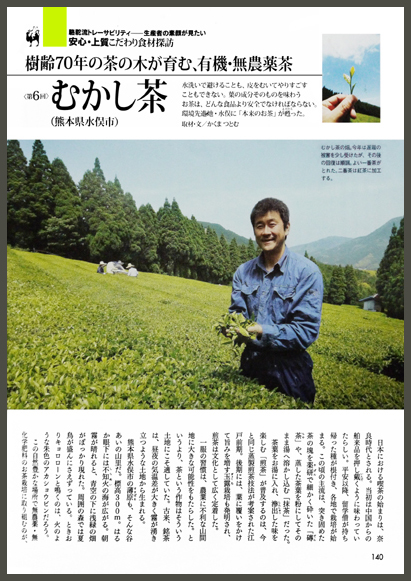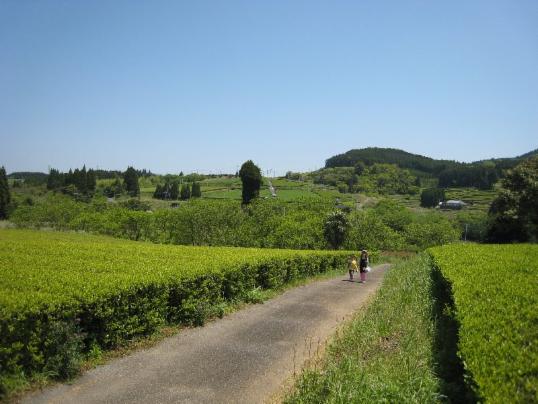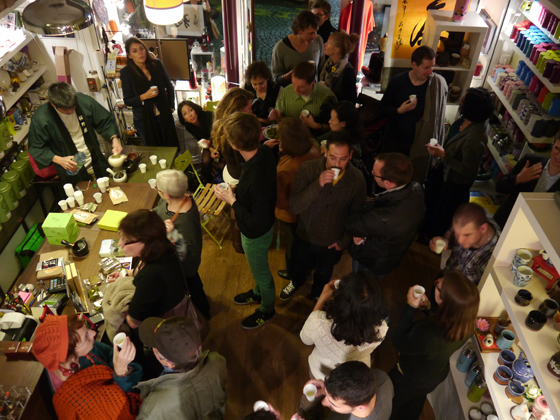SAKURA-NO SENCHA AND OTHER EXCLUSIVE GREEN TEA RARITIES FROM MATSUMOTO FAMILY
Growing Tea absolutely without pesticides is of course not the only matter for the operators of Sakura-No En, the Matsumoto Family. A part of the garden has been converted to a form of cultivation, which uses absolutely no fertilizers – even no organic fertilizers – following a Japanese cultivation concept. Two of our new teas, which are imported for the first time this spring [2012] in a very small amount, derive from this naturally growing tea gardens: Sakura-No Mukashi-Cha and Sakura-No Kama-Cha. Both of them stem from the leaves of seed grown bushes [so called Zairaishu-bushes], which are to be found very rarely. Because of grown from seeds, their roots go much deeper into the ground, which is different to bushes grown from cut boughs [so called cuttings or cions], which are used usually. The bushes of Sakura-No En, which are in use today for both teas, Mukashi-Cha and Kama-Cha, are already 70 years old and can almost become 300 years old. Plants raised out of scions instead, can only become about 30-40 years. Both, the non-fertilizer concept and the concept of growing plants out of seeds, have a strong influence on the taste of the teas. While this way of cultivation is often seen as revolutionary, the Matsumoto Family is convinced that this is the most traditional way of growing tea. By regarding the history of tea properly, this is thoroughly understandable. There are not so many tea gardens that – while cultivating Zairaishu-bushes and following the concept of non-fertilization – manage to create sorts of tea, which are as highly valued by experts as the Sakura-No En teas. Thanks to this, many articles about Sakura-No En and their teas are found in gourment-magazines, catalogues for special presents, and newly also one in a Japanese lifestyle magazine [see below]. |
 |
|
As a matter of course the Morimotos cultivate tea without artificial fertilizers. Since the Family is convinced that the above mentioned concept is much more wide-ranging and deeper than the common organic standards, the questions if to get certified according to the Japanese or European standards, is not relevant from their point of view. Naturally, the disadvantage of this is that no third party supervises their cultivation. Though, when we were visiting the family for the first time in 2010, they convinced us of their concept on a very credible way. It was not only important for us that the Matsumotos were able to explain their concept in detail. Though, also the story of young Mr. Matsumoto and how he persuaded his parents that the family should begin to produce their tea naturally, convinced us of their concept. As a tea garden with traditional background – the tea was also delivered to the Japanese emperor – his parents were afraid to lose their good name. The cause for this concern was that organic agriculture, even in nowadays, was regarded as critic against all the conventional tea gardens and against the Japanese tea culture at all. Today this perspective is changing step by step. Nevertheless, it is impossible to ignore that tea cultivation in Japan is dominated by conventional cultivation and conventional products [non-organic], even today. With the great diversity of the Matsumoto family’s teas from Sakura-No En, we hopefully contribute to a change of the reception of tea culture, which we regard as very desirable, also here in Europe. Hence, we decided to import the teas of Sakura-No En also without organic certification, and we are very happy to have such a range of fantastic green teas in our assortment. Now, it was four times that we visited the Matsumoto family. Twice we brought our customers with us, who were not only filled with enthusiasm because of the high quality of the teas, but also by the heartily atmosphere. After Mr. Matsumoto was in Frankfurt in autumn 2011, he was again in Europe from September 17th to 28th 2012 and introduced his teas to tea houses and specialty shops in Europe.
Paris, September 2012 |
 ,
,